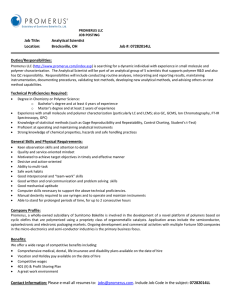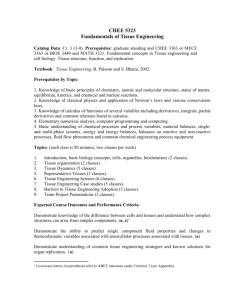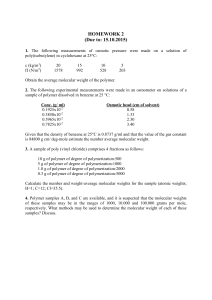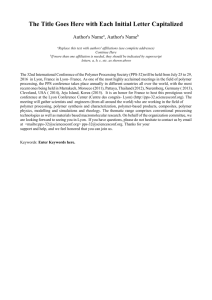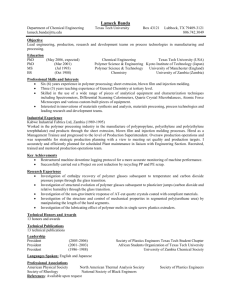CHEE 2332 Chemical Engineering Thermodynamics I
advertisement
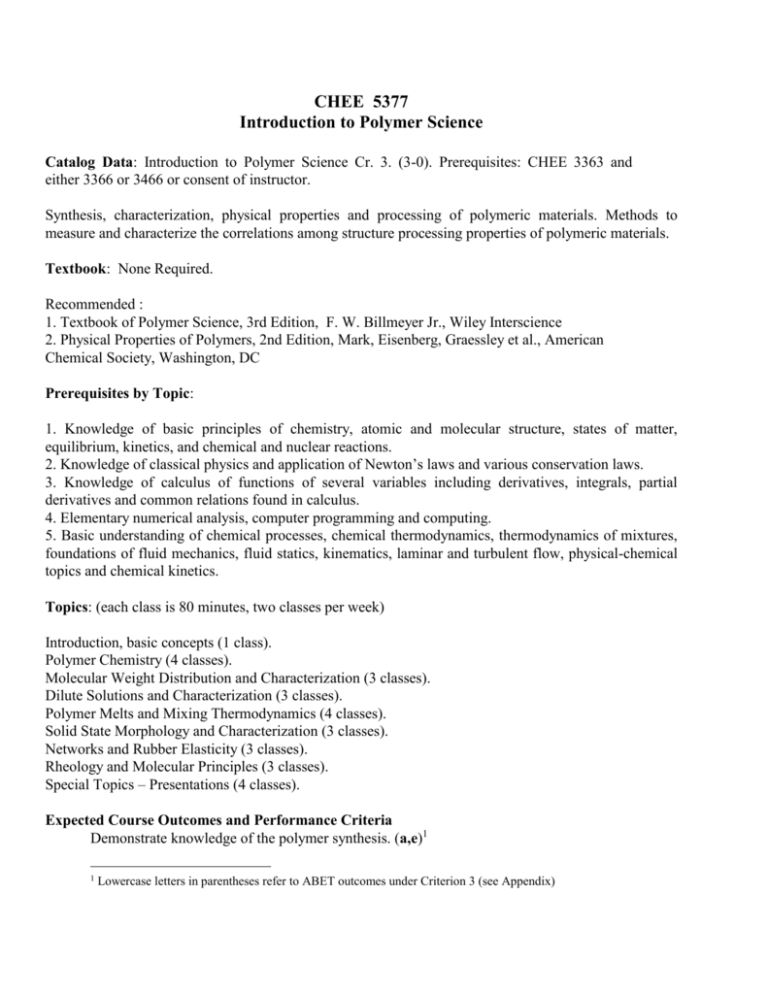
CHEE 5377 Introduction to Polymer Science Catalog Data: Introduction to Polymer Science Cr. 3. (3-0). Prerequisites: CHEE 3363 and either 3366 or 3466 or consent of instructor. Synthesis, characterization, physical properties and processing of polymeric materials. Methods to measure and characterize the correlations among structure processing properties of polymeric materials. Textbook: None Required. Recommended : 1. Textbook of Polymer Science, 3rd Edition, F. W. Billmeyer Jr., Wiley Interscience 2. Physical Properties of Polymers, 2nd Edition, Mark, Eisenberg, Graessley et al., American Chemical Society, Washington, DC Prerequisites by Topic: 1. Knowledge of basic principles of chemistry, atomic and molecular structure, states of matter, equilibrium, kinetics, and chemical and nuclear reactions. 2. Knowledge of classical physics and application of Newton’s laws and various conservation laws. 3. Knowledge of calculus of functions of several variables including derivatives, integrals, partial derivatives and common relations found in calculus. 4. Elementary numerical analysis, computer programming and computing. 5. Basic understanding of chemical processes, chemical thermodynamics, thermodynamics of mixtures, foundations of fluid mechanics, fluid statics, kinematics, laminar and turbulent flow, physical-chemical topics and chemical kinetics. Topics: (each class is 80 minutes, two classes per week) Introduction, basic concepts (1 class). Polymer Chemistry (4 classes). Molecular Weight Distribution and Characterization (3 classes). Dilute Solutions and Characterization (3 classes). Polymer Melts and Mixing Thermodynamics (4 classes). Solid State Morphology and Characterization (3 classes). Networks and Rubber Elasticity (3 classes). Rheology and Molecular Principles (3 classes). Special Topics – Presentations (4 classes). Expected Course Outcomes and Performance Criteria Demonstrate knowledge of the polymer synthesis. (a,e)1 1 Lowercase letters in parentheses refer to ABET outcomes under Criterion 3 (see Appendix) Demonstrate the ability to characterize polymer materials. (a,e) Demonstrate understanding of structure – property correlations. (a,j) Apply knowledge towards preparing and presenting a report on a topic where detailed understanding of a sub-topic is required. (a,c,g,j,k) Evaluation: 1. Homework 2. Examinations/quizzes 3. Project. ABET Outcome, Criterion 3 (a) an ability to apply knowledge of mathematics, science and engineering. (b) an ability to design and conduct experiments as well as to analyze and interpret data. (c) an ability to design a system, component, or process to meet desired needs within realistic constraints such as economic, environmental, social, political, ethical, health & safety, manufacturability, and sustainability. (d) an ability to function on multidisciplinary teams. (e) an ability to identify, formulate and solve engineering problems. Appendix Program-Specific Outcomes Use chemistry and physics concepts to set up and solve chemical engineering problems Use mathematical tools to solve chemical engineering problems Select appropriate experimental equipment and techniques necessary to solve a given problem Evaluate and interpret experimental results using statistical tools and chemical engineering concepts Apply material and energy balance concepts to design a unit operation Define objectives and perform the design of an integrated chemical process under realistic constraints (f) an understanding of professional and ethical responsibility. (g) an ability to communicate effectively. (h) the broad education necessary to understand the impact of engineering solutions in a global, economic, environmental, and societal context. (i) a recognition of the need for and an ability to engage in life-long learning. (j) a knowledge of contemporary issues. (k) an ability to use the techniques, skills, and modern engineering tools necessary for engineering practice. Define roles and responsibilities to align with capabilities of team members and fulfill project requirements Develop and carry out a project plan through team work Translate an engineering problem into a mathematical model or other suitable abstraction Use mathematical model or other suitable abstraction to solve an engineering problem and interpret results Demonstrate knowledge of professional code of ethics. Identify ethical issues and make decisions for a chemical engineering problem. Make presentations that are factual and tailored to the audience Can communicate in writing to non-technical and technical audiences Understand the impact of chemical engineering solutions in a global, economic, environmental, and societal context. Recognize the importance of advanced education and development opportunities Identify, retrieve, and organize information necessary to solve open-ended problems Know the interplay between current technical and societal issues Know the recent history, current status, and future trends of chemical engineering Use modern software to solve chemical engineering problems Understand how to operate equipment relevant to chemical engineering systems
